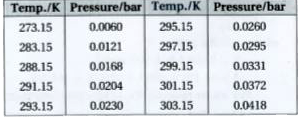Given Dalton.s Law of partial Pressure, its mathematical formula and explain aqueous tension. Solution in Gujrati
Dalton.s law : The law was formulated by John Dalton in 1801. ..It states that the total pressure exerted by the mixture of non - reactive gases is equal to the sum of the partial pressures of individual gases...
i.e., the pressures which these gases would exert if they were enclosed separately in the same volume and under the same conditions of temperature.
Partial pressure (p) : In a mixture of gases, the pressure exerted by the individual gas is called .Partial pressure..
Mathematical formula of Dalton.s Law of partial pressure : Where pTotal is the total pressure exerted by the mixture of gas and p1,p2,p3 etc. are partial pressures of gases.
pTotal=p1+p2+p3+..... (at constant T and V) ..... (Eq.-i)
Pressure of dry gas : Gases are generally collected over water and therefore are moist. So we have to obtained pressure of dry gas.
(Pressure ofDry gas)=⎛⎜⎝Total pressure ofmoist gas containswater vapour⎞⎟⎠−(Vapour pressureof water)
∴pDry gas=(pTotal−pAqueous tension) ....(Eq.-ii)
Aqueous tension : Pressure exerted by saturated water vapour is called .aqueous tension.. Aqueous tension of water at different temperature is given in table.

Necessity to follow Dalton.s law : (i) Gases of Mixture are do not react with each other chemically (ii) Temperature and pressure of different gases remains same.
Topper's Solved these Questions
- BOOK - KUMAR PRAKASHANCHAPTER - STATES OF MATTER EXERCISE - SECTION - A QUESTIONS (Sub Question)3videos
STATES OF MATTER
- BOOK - KUMAR PRAKASHANCHAPTER - STATES OF MATTER EXERCISE - SECTION - A QUESTIONS (TRY YOUR SELF)47videos
STATES OF MATTER
- BOOK - KUMAR PRAKASHANCHAPTER - SOME BASIC CONCEPTS OF CHEMISTRYEXERCISE - Section - D (Solutions of NCERT Exemplar Problems) (Long Answer Type Questions)4videos
SOME BASIC CONCEPTS OF CHEMISTRY
- BOOK - KUMAR PRAKASHANCHAPTER - STRUCTURE OF ATOMEXERCISE - QUESTINS PAPER FROM MODULE (SECTION -D)2videos
STRUCTURE OF ATOM
Similar Questions
Derive Boyle.s formula according to his law.
View SolutionAt 300 K constant temperature gas having 20cm3, 1 bar pressure it is convert into 50cm3 then calculated pressure ?
03:49View SolutionA vessel contains 1.6 g of dioxygen at STP (273.15 K, 1 atm pressure). The gas is now transferred to another vessel at constant temperature, where pressure becomes half of the original pressure. Calculate
(A) volume of the new vessel.
(B) number of molecules of dioxygen.05:06View SolutionExplain Heisenberg’s uncertainty principle.
View Solutionऊष्मा गतिकी के प्रथम नियम को व्याख्या करके इसके गणितीय रूप को समझाइए।
05:06View SolutionState and explain Dalton's law of partial pressures.
02:14View SolutionState and explain Dalton's law of partial pressures.Derive the relation between partial pressure and total pressure.
04:12View Solutionअणुगति सिद्धान्त के आधार पर डॉल्टन के आंशिक दाब नियम की व्यत्पत्ति कीजिये।
02:13View SolutionDalton's Law of Partial Pressure & Aqueous tension
08:23View SolutionState Dalton's law of partial pressure and write mathematical form.
View SolutionExplain and explain Dalton's law of partial pressures.
01:32View SolutionMathematical form of Dalton.s Law of Partial Pressure.
03:49View SolutionExplain Dalton's law of partial pressures and Charles’ law.
03:49View SolutionWhich postulate of Dalton.s atomic theory can explain the law of definite proportions ?
View SolutionPartial pressure of water vapour is also known as ............ [aqueous tension/surface tension]
03:49View Solution
